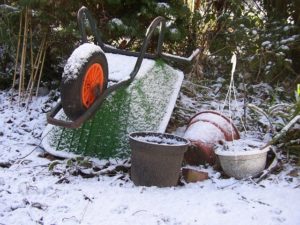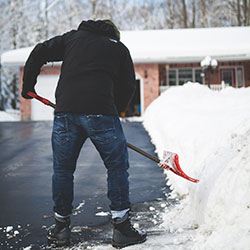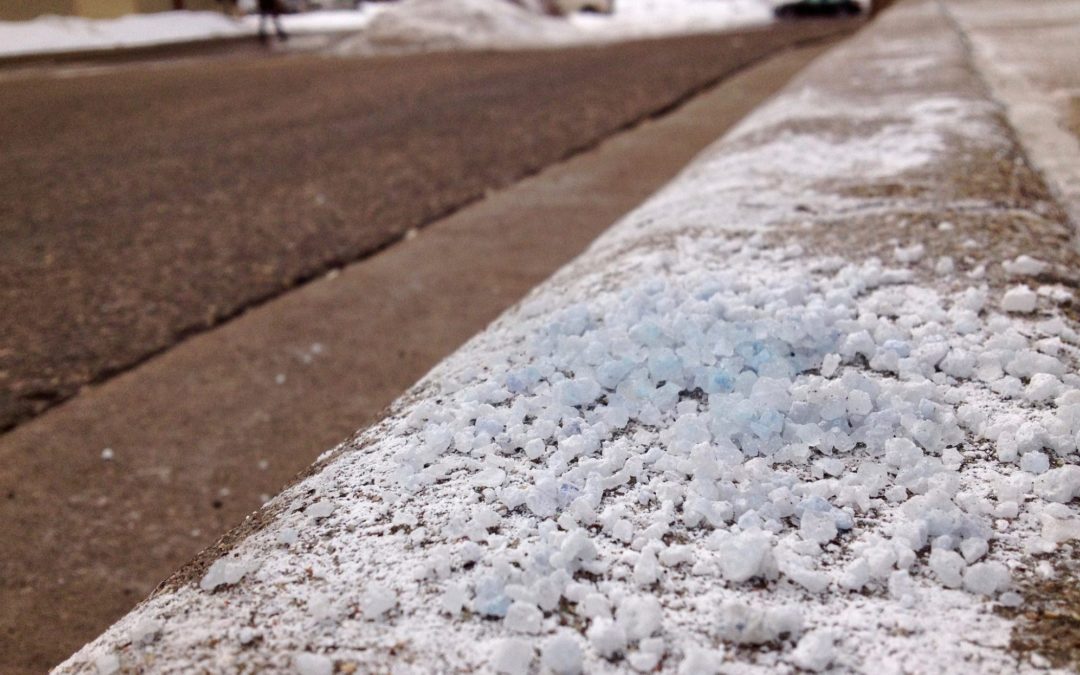Road salt is one of those necessary evils all Canadians have to contend with. It might leave a stain on shoes and pants and prematurely rust your car, but darn it, it keeps us safe in the winter!
However, many of us tend to go nuclear as soon as the weather dips below zero, and the bags of salt we pour onto our steps, walkways, and sidewalks can do a lot of damage to concrete and plants. There is a proper way to salt without causing damage, and it can still keep you from dangerous slips and falls!
How Salt Works
Most bags of rock salt you buy during the winter are made of sodium chloride, calcium chloride, or magnesium chloride. They work by lowering the freezing point of the ice and breaking the rigid bonds of the frozen water. Don’t worry about the fancy names, they’re all still salt, but they have different attributes:
- Sodium chloride is your average table salt. You can use it, but finding this type in a gigantic bag at a hardware store will be tough. This is because the other chlorides have proven to be more effective.
- Calcium chloride is generally what municipalities will use on the roads. It works at a much lower temperature than the other two options, and the science on its side: it breaks down into three ions instead of sodium chloride’s two, meaning more ions get between the bonds holding frozen water together.
- Magnesium chloride also works at low temperatures and has a quick melt time with no lasting residue. If you’re sick of the white powdery film left salt tends to leave behind, magnesium chloride might be for you. However, it loses its effect much quicker, meaning you have to apply more of it to make it work. It also tends to cost more.
Mix It Up
 Many salt users will pour a lot on their steps and sidewalks in an attempt to both melt the ice and gain some traction. The problem is that the chlorides will get into the porous concrete and degrade it, causing cracks and damage. It’s recommended that you mix the salt with sand to prevent over-salting and get that much-needed grit while the ice breaks up.
Many salt users will pour a lot on their steps and sidewalks in an attempt to both melt the ice and gain some traction. The problem is that the chlorides will get into the porous concrete and degrade it, causing cracks and damage. It’s recommended that you mix the salt with sand to prevent over-salting and get that much-needed grit while the ice breaks up.
Applying The Salt
Too little salt won’t be effective, but too much will harm your property – getting it right requires more than just scooping handfuls onto the concrete. Before you apply the salt, make sure to shovel away as much as you can. This makes the salt more effective and reduces the amount you have to sprinkle on the ground. Shovelling might add some extra strain to the chore, but it will protect the concrete and your plants from the effects of too much salt.
When you’ve removed as much as you possibly can, sprinkle the salt of your choice on the surface. It should start working right away, but wait some time for the ice to break down. If it’s thick ice and compact snow, you can take a shovel to it and break it away. Put down some sand after this to get some traction on the concrete without using more salt.
Sidewalk Salt and Your Lawn
 There’s a reason why ancient armies would apply salt to the fields of their enemies: it kills plants and prevents new ones from sprouting. Salt naturally occurs in soil, but if the chloride levels become too high, the feeding processes the plants use to live will be interrupted, choking them off and killing them.
There’s a reason why ancient armies would apply salt to the fields of their enemies: it kills plants and prevents new ones from sprouting. Salt naturally occurs in soil, but if the chloride levels become too high, the feeding processes the plants use to live will be interrupted, choking them off and killing them.
This is why it’s a good idea to mix the salt with another gritty substance and to deice the sidewalk as much as possible before sprinkling it with the salt. These easy tactics reduce the amount of salt you need to use, ensuring that as little salt as possible dissolves and washes onto your lawn or garden. When the weather gets warmer, clean off the salt quickly with some warm water and a stiff brush. Contact us if you want to learn more about winter landscaping and snow removal!


Recent Comments